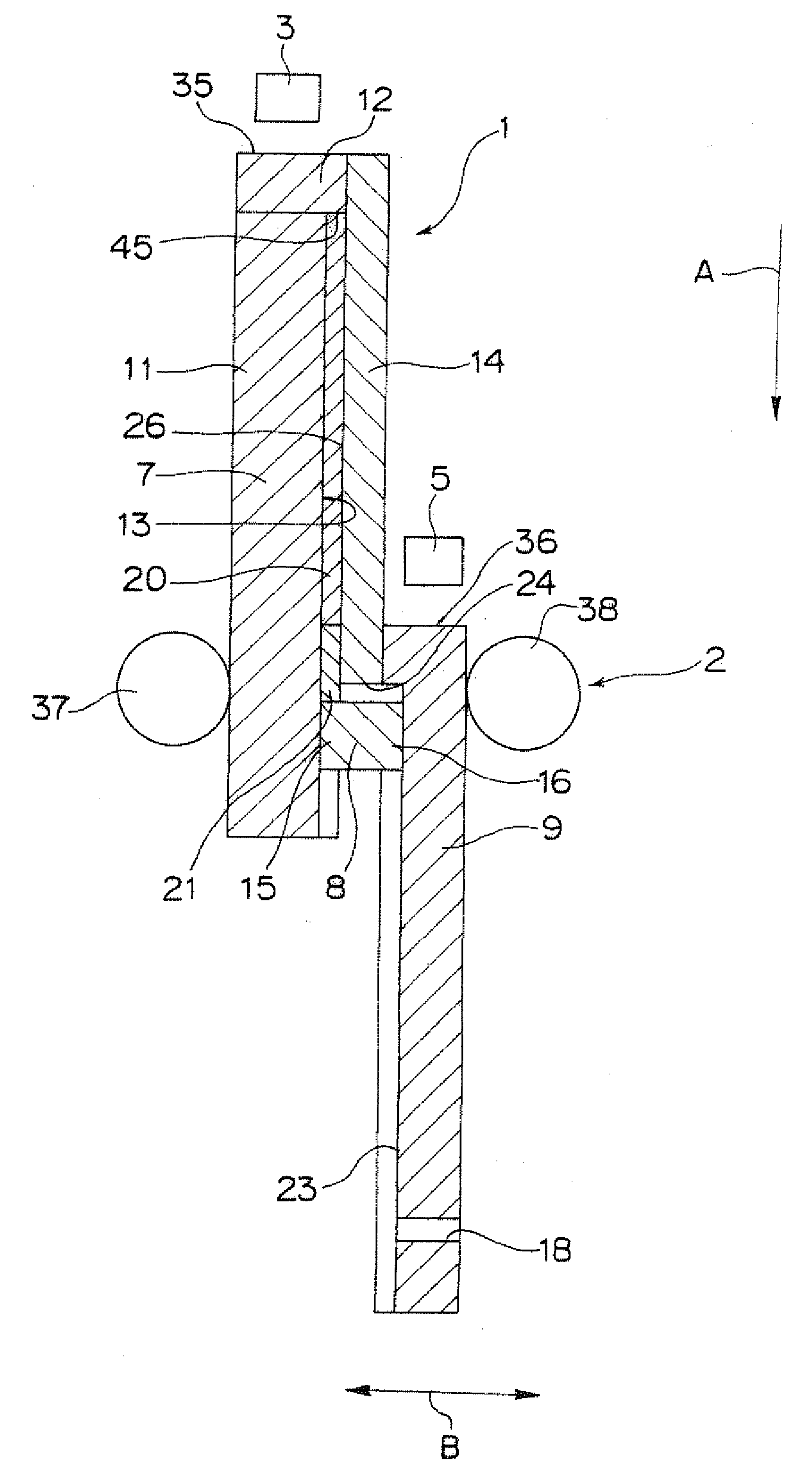Composite mold, plastic working device for workpiece material, and plastic working method for workpiece material
a technology of working device and workpiece material, which is applied in the direction of extrusion die, drawing profiling tool, manufacturing tools, etc., can solve the problems of large dynamic frictional force between the workpiece material and the passage wall surface, large shearing force and accompanying severe strain on the workpiece material, and molds to be early worn or damaged, so as to reduce the grain size of the workpiece material, reduce the pressurizing force to be applied to the workpiece material, and reduce the grain
- Summary
- Abstract
- Description
- Claims
- Application Information
AI Technical Summary
Benefits of technology
Problems solved by technology
Method used
Image
Examples
first embodiment
[0125]FIG. 1A is a sectional view of a plastic working device for workpiece material according to the invention (hereinafter, referred to as plastic working device). In FIG. 1A, reference numeral 20 denotes a titanium material made of pure titanium, which is an example of the workpiece material, and 21 denotes a dummy material serving for easier extrusion of the titanium material 20.
[0126]As shown in FIG. 1A, the plastic working device includes a composite mold 1 of the first embodiment of the invention, a retainer unit 2, a preloading press 3 as an example of a first relative movement unit, and a preloading press 5 as an example of a second relative movement unit. The composite mold 1 has a first mold 7, a second mold 8 and a third mold 9. The first mold 7, the second mold 8 and the third mold 9 are made of a mold metal.
[0127]The first mold 7 has a body portion 11 and an end portion 12. The body portion 11 has a generally rectangular parallelepiped shape. At a roughly widthwise cen...
second embodiment
[0188]According to the composite mold of the second embodiment, the workpiece material retained by the groove 13 of the first mold 7 can be easily pushed into the groove 23 of the third mold 9 via the through hole 24 of the second mold 78, and conversely, the workpiece material retained by the groove of the third mold 9 can be easily pushed into the groove 13 of the first mold 7 via the through hole 24.
[0189]In addition, in the composite mold of the second embodiment, the side face portion 51 for bending the workpiece material in the first guide portion 15 of the first mold 7, and the first portion 84 in one side face of the through hole 24, are positioned so as to be generally flush with each other, and moreover the portion 81 of the side face of the second guide portion 86 and the second portion 85 generally perpendicular to the first portion 84 in the side face of the through hole 24 are positioned so as to be generally flush with each other. However, in the case where the cross-...
fourth embodiment
[0190]Also in the case where the cross-sectional shape of the through hole of the second mold is a generally rectangular shape, it is also allowable, as the composite mold of the invention, that the side face portion for bending the workpiece material in the first guide portion and the first portion in one side face of the through hole are positioned so as to be generally flush with each other while a portion of one side face of the second guide portion and the second portion of a side face of the through hole generally parallel to the first portion are positioned so as to be generally flush with each other.
[0191]FIG. 5A is a perspective view showing a shape of a workpiece material 91 which is being extruded from the groove 13 of the first mold 7 to the groove 23 of the third mold 9 in the composite mold 1 of the first embodiment. FIG. 5B is a perspective view showing a shape of a workpiece material 92 which is being extruded from the groove 13 of the first mold 7 to the groove 23 o...
PUM
| Property | Measurement | Unit |
|---|---|---|
| shape | aaaaa | aaaaa |
| cross-sectional shape | aaaaa | aaaaa |
| pressing force | aaaaa | aaaaa |
Abstract
Description
Claims
Application Information
 Login to View More
Login to View More - R&D
- Intellectual Property
- Life Sciences
- Materials
- Tech Scout
- Unparalleled Data Quality
- Higher Quality Content
- 60% Fewer Hallucinations
Browse by: Latest US Patents, China's latest patents, Technical Efficacy Thesaurus, Application Domain, Technology Topic, Popular Technical Reports.
© 2025 PatSnap. All rights reserved.Legal|Privacy policy|Modern Slavery Act Transparency Statement|Sitemap|About US| Contact US: help@patsnap.com



